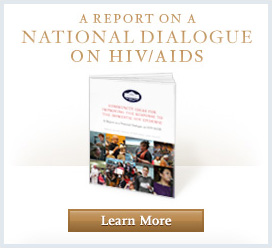Community Ideas for Improving the Response to the Domestic HIV Epidemic
A Report on a National Dialogue on HIV/AIDS
- Download the report (PDF)
- En español (PDF)
Executive Summary
At the beginning of his Administration, President Obama instructed the White House Office of National AIDS Policy (ONAP), a component of the Domestic Policy Council (DPC), to develop a National HIV/AIDS Strategy and re-focus our response to the HIV epidemic in the United States. The President directed that this strategy be driven by three primary goals:
- Prevent new HIV infections.
- Increase access to care and optimize health outcomes.
- Reduce HIV-related health disparities.
From the beginning, ONAP recognized that community involvement was essential in creating a more effective strategy for combating HIV/AIDS in America. To achieve this undertaking, ONAP developed a comprehensive approach for gathering public input and ensuring that ideas from individuals living with HIV, as well as other stakeholders and interested parties, were reflected in the Nation’s roadmap for moving forward. ONAP conducted 14 community discussions in locations across the United States and its territories and spoke with more than 4,200 people. ONAP also solicited recommendations for the strategy through the White House Web site. Over 1,000 written recommendations for the National HIV/ AIDS Strategy were submitted to ONAP from the community discussions or Web-related submissions. This report is a summary of these community recommendations.
Recommendations related to prevention were made against a backdrop of growing HIV prevalence in the United States. People commonly suggested that we need a broad-based, public information campaign. Individuals told us that this campaign should be vast in scope and should educate a public that remains highly vulnerable to HIV infection. Participants at the community discussions noted that population-specific interventions are crucial. Moreover, they said that any public action must address the numerous social, economic, and behavioral factors that fuel HIV transmission.
Public comments and written testimonies related to improving access to care shared common themes with those related to prevention and health disparities. In particular, consumers of HIV/AIDS services, as well as services providers and advocates, warned about defining populations too broadly and not recognizing the depth or diversity that exist within subpopulations disproportionately affected by the epidemic. Participants primarily discussed access to care in terms of the broad array of health and social services that are necessary for chronic disease management and long-term wellbeing. They spoke pas¬sionately about the need for comprehensive health insurance coverage, culturally competent provid¬ers, and a greater number of HIV care providers in underserved rural and urban communities. Perhaps because, comparatively speaking, more people access primary medical care than other services, many testimonies focused on how to make these other services more accessible, including transportation, housing, and job training.
Participants suggested that expanding access to care could help reduce HIV transmission rates and alleviate health disparities. Advocates from or representing vulnerable populations discussed many of the disparities evident in today’s epidemic, ranging from racial and ethnic disparities to sex and gender, sexual orientation, age, immigration status, and geographic disparities. Nearly all of the comments referenced the structural inequalities that contribute to these issues. The President’s three goals are interconnected, and many participants’ recommendations regarding issues, opportunities, and chal¬lenges spanned the topics of prevention, access to care, and health disparities. These recommendations most commonly focused on the need for more streamlined funding processes and greater collaboration among Federal, State, and local agencies to facilitate more efficiency. They also addressed the need to increase specificity in the Nation’s surveillance data and inequities in the Nation’s public and private insurance markets. People also expressed concerns about the shortage of health professionals, specifically of those qualified to address HIV/AIDS, and called for remedies to address this problem.



